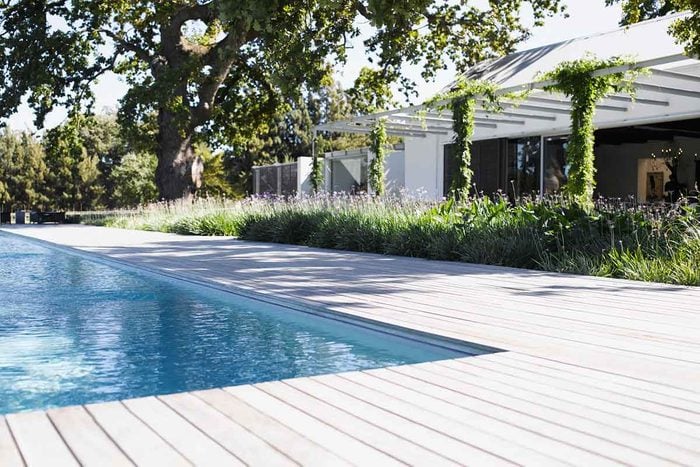How to Choose the Best Pool Decking Option For Your Backyard
Updated: Mar. 13, 2024

Make the most of your backyard pool by wrapping it in pool decking. Here are some of the most common pool decking options.
Our editors and experts handpick every product we feature. We may earn a commission from your purchases.
A swimming pool without a deck is like a cup without a saucer — they go together naturally.
You installed your pool as a place for backyard family fun, but just as much fun takes place around the pool as it does in it. Pool decking, or the border area around your pool, provides space for lounge chairs, sun umbrellas, patio dining sets, gear storage boxes and more. As a perimeter between the pool and your yard, it also helps keep lawn clippings and other garden debris from winding up in the pool.
Depending on the type of pool you’ve installed and your budget for the project, there’s a just-right pool decking solution for you and your family. To help you decide, let’s look at some of the most common pool decking options.
On This Page
Concrete Pool Decking
Poured concrete pool decking offers a range of affordable, entry-level options. Concrete decking is also a durable choice, though cracks are inevitable. Concrete decking finishes and upgrades include:
- Brushed or broom-swept concrete. The simplest decking solution involves pouring large sections of concrete and sweeping it with a broom as it dries. This creates a non-slip texture but may feel rough under bare feet. Pouring in smaller sections, or sawing larger sections to leave joints in-between, can help prevent cracking. Expect to pay between $5 and $10 per square foot, depending on where you live and on material availability.
- Colored concrete. Brushed concrete pool decking can be upgraded by adding color to the wet concrete. This provides a custom look that’s more attractive than plain gray concrete, without adding much to your bottom line. One drawback of colored concrete: If a section needs to be replaced, you’re unlikely to match the original color.
- Stamped concrete. One of the most popular and attractive options for concrete pool and patio decking, stamped concrete is poured in slabs, then imprinted with large stamps to form uniform or semi-uniform patterns. The concrete is colored and the stamps create different effects, similar to irregular stone slabs, bricks, pavers, tile or wood. Sealant can make stamped concrete more slippy than brushed concrete. Stamped concrete costs from $12 to $20 per square foot, depending on the complexity of the design and how many colors are used.
- Textured concrete. The middle ground between brushed and stamped concrete, textured concrete is poured in smaller sections and incised with joints and lines, by hand or with a saw. It costs $8 to $10 per square foot.
Pool Deck Pavers
Like pavers used for patios and walkways, pool deck pavers offer lots of looks, especially if you play around with color, shape and installation patterns. Pavers vary widely in price, between $5 and $40 per square foot installed, depending on the material.
Whether you go with concrete, natural stone or brick pavers, if one breaks, it can be easily replaced — a big plus. Like all types of pavers, pool deck pavers need proper prep and underlay, but a skilled DIYer can install them.
- Concrete paving stones are the cheapest at about $5 to $10 per square foot. They’re textured and slip-resistant, but need to be sealed and periodically resealed to prevent water absorption.
- Stone pavers are the most expensive option but offer the most versatility in color, texture and design. They also resist fading, cracking and water absorption.
- Brick pavers can create a beautiful look, and they’re easy to replace if one or more of them crack. But they aren’t ideal in areas where there’s a lot of shade or humidity, because moss may grow on them and make them slippery.
P.S. If you’ve ever found curious woodland animals swimming in your backyard pool, the FrogLog is just what you need.
Wood and WPC Pool Decking
If you have a permanently installed above-ground pool and want to build a raised deck level with the top of the pool, concrete or pavers aren’t an option. Wood or wood plastic composite (WPC) are best for raised decks around above-ground pools. And if you’ve got the skills, you can do the installation yourself. Note that wood or WPC can also be used for in-ground pools.
- Wood pool decking. With wood decking, you get what you pay for. The more expensive the wood, the more your pool deck will resist mold, insect damage, water absorption and rot. Common pool decking wood includes pine, cedar, teak and mahogany. The latter two are the most durable pest-resistant options and require the least maintenance. But they’re also the most expensive, at $10 to $15 per square foot.
- WPC pool decking. Sold under different brand names, WPC (sometimes called wood polymer composite) is made from wood pulp and recycled plastic. WPC is pest-resistant, won’t rot or splinter, resists fading and requires little to no maintenance. At $50 or more per square foot installed, it has a higher initial cost than other pool deck materials, but proponents say it pays off in longevity and lack of maintenance. Besides cost, another drawback of WPC is that it can become uncomfortably hot underfoot.
Retractable Pool Deck
If your pool is seasonal or if you have a small pool area, you may wish to invest in a retractable pool deck. This slides over the surface of the pool, providing a solid cover that’s sturdy enough for patio furniture and foot traffic. Small retractable decks start at around $15,000.
